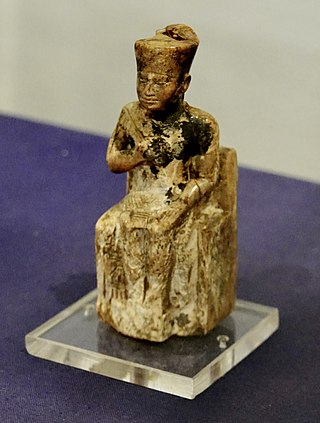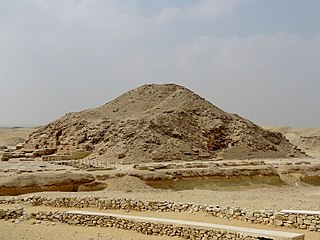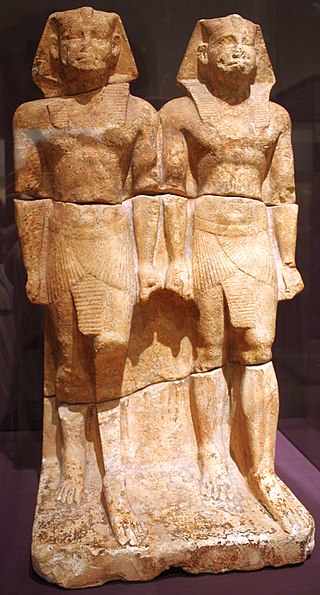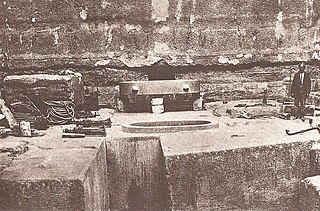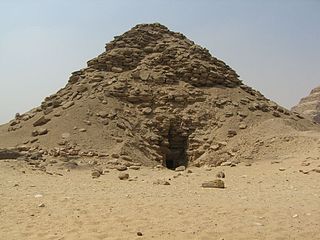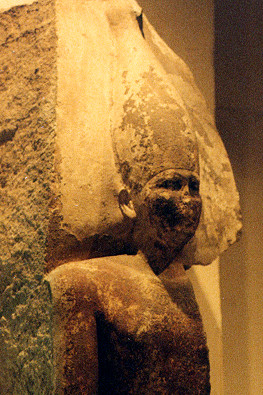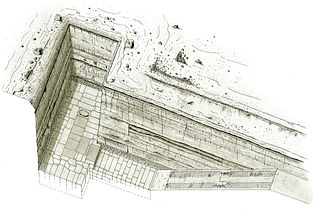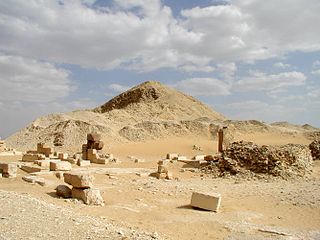This list presents the vital statistics of the pyramids listed in chronological order, when available.
Contents
| Dynasty | Pharaoh | Modern name (ancient name) | Site | Base length (m) | Height (m) | Volume (m3) | Inclination & notes [ clarification needed ] | Image |
|---|---|---|---|---|---|---|---|---|
| 3rd 2686–2613 BC | Djoser | Pyramid of Djoser | Saqqara | 121×109 | 60 | 330,400 | 29°52′16.56″N31°12′59.02″E / 29.8712667°N 31.2163944°E [1] |  |
| 3rd | Sekhemkhet | Buried Pyramid | Saqqara | 120 | 7 | 33,600 (unfinished) | 29°51′58″N31°12′47″E / 29.866°N 31.213°E [2] Unfinished pyramid convered into a square mastaba. |  |
| 3rd | Khaba (uncertain) | Layer Pyramid | Zawyet el'Aryan | 84 | 20 | 47,040 (possibly unfinished) | 29°55′58″N31°09′41″E / 29.932820°N 31.161262°E [3] |  |
| 4th 2613–2498 BC | Sneferu | Pyramid of Meidum (Snefru endures) | Meidum | 144 | 65 | 638,733 (possibly unfinished) | 51° 50' 35" [4] |  |
| 4th | Sneferu | Bent Pyramid (Snefru shines in the South) | Dahshur | 188 | 105 | 1,237,040 | 54° 50' 35" /43° 22' [4] | 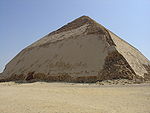 |
| 4th | Sneferu | Red Pyramid (Snefru shines in the North) | Dahshur | 220 | 105 | 1,694,000 | 43° 22' |  |
| 4th | Khufu | The Great Pyramid of Giza (Khufu's horizon) | Giza | 230.3 | 146.6 | 2,583,283 | 51° 50' 40" [5] |  |
| 4th | Djedefre | Pyramid of Djedefre (Djedefre's Starry Sky) | Abu Rawash | 106.2 | 67 | 131,043 (possibly unfinished) | ~52° [4] [6] |  |
| 4th (uncertain) | Bikheris? | Northern Pyramid of Zawyet el'Aryan (Star of ..?..-Ka) | Zawyet el'Aryan | 200 | (Never built) | [8] [9] |  | |
| 4th | Khafre | Pyramid of Khafre (Khafre is great) | Giza | 215.25 | 143.5 | 2,211,096 | 53°10' [4] |  |
| 4th | Menkaure | Pyramid of Menkaure (Menkaure is divine) | Giza | 103.4 | 65.5 | 235,183 | 51°20′25″ [10] |  |
| 5th 2498–2345 BC | Userkaf | Pyramid of Userkaf (The pure sites of Userkaf) | Saqqara | 73.3 | 49 | 87,906 | 53°7'48" [4] |  |
| 5th | Sahure | Pyramid of Sahure (The personality (ba) of Sahure appears) | Abusir | 78.75 | 47 | 96,542 | 50°11'40" [4] | 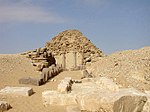 |
| 5th | Neferirkare Kakai | Pyramid of Neferirkare (Personality (ba) of Neferirkare) | Abusir | 105 | 54 | 257,250 | 54°30' [11] |  |
| 5th | Neferefre | Pyramid of Neferefre (The power of Neferefre is divine) | Abusir | 65 | 29,575 (unfinished) | Unfinished pyramid convered into a square mastaba. |  | |
| 5th | Shepseskare | Unfinished pyramid of North Abusir | Abusir | 100 | Never built, earthwork just started | – | ||
| 5th | Nyuserre Ini | Pyramid of Nyuserre (The seats of Niuserre will endure) | Abusir | 79.9 | 51.68 | 112,632 | 51° 50' 35" [12] |  |
| 5th | Menkauhor Kaiu [13] | Headless Pyramid (The divine places of Menkauhor) | Saqqara | c. 52 | n.d. | n.d. | ||
| 5th | Djedkare Isesi | Pyramid of Djedkare-Isesi (Beautiful is Djedkare) | South Saqqara | 78.75 | 52.5 | 107,835 | 52° [14] |  |
| 5th | Unas | Pyramid of Unas (The places of Unas are beautiful) | North Saqqara | 57.75 | 43 | 47,390 | 56° [4] | 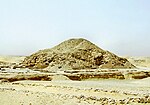 |
| 6th 2345–2181 BC | Teti | Pyramid of Teti (The places of Teti are enduring) | North Saqqara | 78.5 | 52.5 | 107,835 | 53° 7' 48" [15] |  |
| 6th | Pepi I | Pyramid of Pepi I (The beauty of Pepi may endure) | South Saqqara | 78.75 | 52.5 | 107,835 | 53° 7' 48" [16] | |
| 6th | Merenre | Pyramid of Merenre (The beauty of Merenre appears) | South Saqqara | 78.75 | 52.5 | 107,835 | 57°7'48" |  |
| 6th | Pepi II | Pyramid of Pepi II (Pepi is established and living) | South Saqqara | 78.75 | 52.5 | 107,835 | 53° 7' 48" [5] | 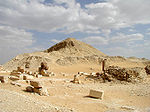 |
| 8th | Qakare Ibi | Pyramid of Ibi | South Saqqara | 31.5 | 21? | 53° 7′ [17] |  | |
| First Intermediate Period | Khui | Pyramid of Khui | Dara | 146x136 | n.d. | n.d. [18] |  | |
| 10th | Merikare | Pyramid of Merikare (Flourishing are the abodes of Merikare) | Unknown, possibly North Saqqara | n.d. | n.d. | n.d. [19] | ||
| 12th 1991–1803 BC | Amenemhat I | Pyramid of Amenemhet I (Amenemhat appears at his place) | Lisht | 84 | 55 | 129,360 | 54° 27' 44" |  |
| 12th | Senusret I | Pyramid of Senusret I (Senusret beholds the two lands) | Lisht | 105 | 61.25 | 225,093 | 49° 24' [20] |  |
| 12th | Amenemhat II | White Pyramid (Amenemhat is provided) | Dahshur | 50 |  | |||
| 12th | Senusret II | Pyramid of Senusret II (Senusret appears) | El-Lahun | 106 | 48.6 | 185,665 | 42° 35' [21] |  |
| 12th | Senusret III | Pyramid of Senusret III | Dahshur | 105 | 78 | 288,488 | 56° 18' 35" [22] |  |
| 12th | Amenemhat III | Pyramid of Amenemhat III (Amenemhat is beautiful) | Dahshur | 105 | 75 | 274,625 | 56° 18' 35" |  |
| 12th | Amenemhat III | Pyramid of Hawara (Amenemhat lives) | Hawara | 105 | 58 | 200,158 | 48° 45' |  |
| 12th or 13th | Amenemhat IV (?) | Southern Mazghuna pyramid | South Mazghuna | 52.5 | (unfinished) | n.d. | n.d. |  |
| 12th or 13th | Sobekneferu (?) | Northern Mazghuna pyramid | North Mazghuna | >52.5 | (unfinished) | n.d. | n.d. |  |
| 13th c. 1790 BC | Ameny Qemau | Pyramid of Ameny Qemau | South Saqqara | 52 | 35 | c 55° |  | |
| 13th | Ameny Qemau (possibly usurped) [23] | n.d. | Dahshur | n.d. | n.d. | n.d. | ||
| 13th c. 1760 BC | Khendjer | Pyramid of Khendjer | South Saqqara | 52.5 | 37.35 | 34,300 | 55° [24] |  |
| 13th | unknown | Southern South Saqqara pyramid | South Saqqara | 78.75 | (unfinished) | n.d. | n.d. |  |
| 13th c. 1740 BC | Likely Neferhotep I | Tomb S9 | Abydos | uncertain | unknown | Likely a pyramid, similar to Khendjer's, but possibly a mastaba |  | |
| 13th c. 1730 BC | Likely Sobekhotep IV | Tomb S10 | Abydos | uncertain | unknown | Likely a pyramid, similar to Khendjer's, but possibly a mastaba |  | |
| 17th | Nubkheperre Intef | Pyramid of Nubkheperre Intef | Dra' Abu el-Naga' | 11 | 13 | n.d. | 60° | |
| 18th (1550–1292 BC) | Ahmose I | Pyramid of Ahmose | Abydos | 52.5 | 10 | n.d. | 60° [25] |  |


